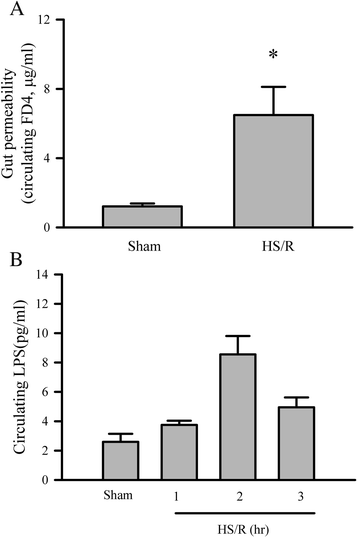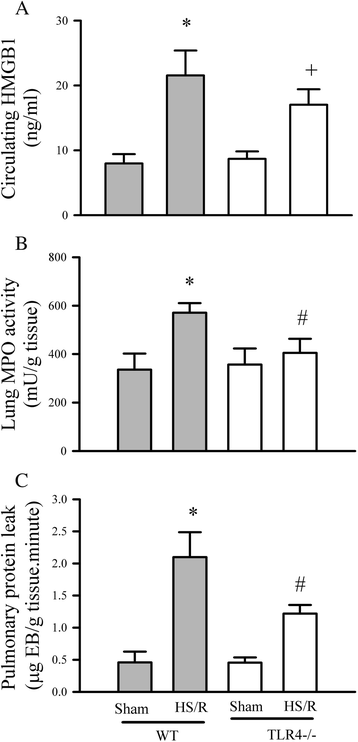Induction of acute lung inflammation in mice with hemorrhagic shock and resuscitation: role of HMGB1
- PMID: 25309129
- PMCID: PMC4193406
- DOI: 10.1186/s12950-014-0030-7
Induction of acute lung inflammation in mice with hemorrhagic shock and resuscitation: role of HMGB1
Abstract
Background: Hemorrhagic shock and resuscitation (HS/R) can induce multiple organ failure which is associated with high mortality. The lung is an organ commonly affected by the HS/R. Acute lung injury is a major cause of dysfunction in other organ systems. The objective of this study is to test the hypothesis that HS/R causes increased gut permeability which results in induction of high mobility group box1 protein (HMGB1) and further leads to the development of acute lung inflammation.
Materials and methods: A mouse model of HS/R was employed in this study. Gut permeability and bacterial translocation were assessed with circulating FD4 and lipopolysaccharide (LPS). Circulating HMGB1 was determined with ELISA. Acute lung inflammation (ALI) was determined with lung myeloperoxidase (MPO) activity and pulmonary protein leakage.
Results: HS/R induced intestinal barrier dysfunction as evidenced by increased circulating FD4 and LPS at 30 min and 2 hrs after resuscitation, respectively. In addition, circulating HMGB1 levels were increased in mice with HS/R as compared with sham animals (p < 0.05). HS/R resulted in ALI (increased lung MPO activity and pulmonary protein leakage in mice with HS/R compared with sham mice, p < 0.05). Inhibition of HMGB1 (A-box and TLR4(-/-)) attenuated the ALI in mice with HS/R. However, inhibition of HMGB1 did not show protective effect on gut injury in early phase of HS/R in mice.
Conclusions: Our results suggest that induction of HMGB1 is important in hemorrhagic shock and resuscitation-induced acute lung inflammation.
Keywords: Acute lung inflammation; Gut injury; HMGB1; Hemorrhagic shock.
Figures




References
LinkOut - more resources
Full Text Sources
Other Literature Sources
Research Materials
Miscellaneous

